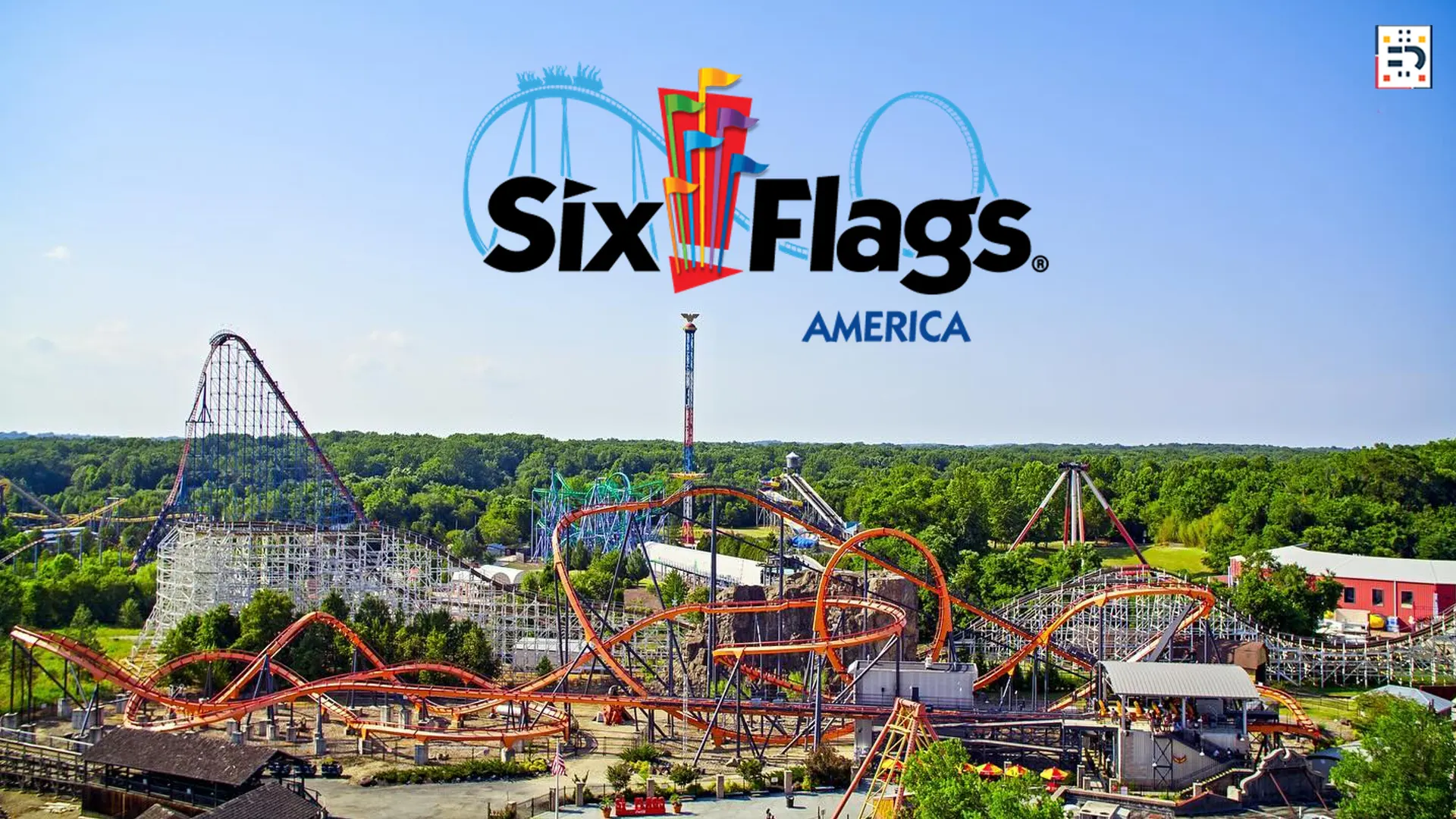Introduction — A Farewell to a Beloved Landmark
The End of an Era: Remembering Six Flags America and What It Means for the Chain. For more than fifty years the park that began as a wildlife preserve grew into a regional amusement staple for Washington, D.C. and Baltimore families. In May 2025 Six Flags announced that Six Flags America and its Hurricane Harbor water park would permanently close at the end of the 2025 season; the parks’ final operating day was Sunday, November 2, 2025. Read the company announcement here: Six Flags press release (BusinessWire).
The Origins of Six Flags America
The site opened in 1974 as a drive-through attraction called The Wildlife Preserve. Over the 1980s and 1990s it evolved through identities — Wild World, Adventure World — gradually adding roller coasters, a water park and themed areas until it became Six Flags America in 1999. A compact history and timeline are available on the park’s Wikipedia page. Six Flags America — Wikipedia.
Key milestones
- 1974 — Opened as The Wildlife Preserve (safari/animal attraction).
- 1986 — The Wild One wooden coaster (a relocated Paragon Park classic) begins operation on site.
- 1999 — Officially rebranded as Six Flags America and integrated with the Six Flags network.
The Wild One has been an especially enduring landmark; you can read its detailed history here: The Wild One — Wikipedia.

The Six Flags Era: 1999–2025
Under the Six Flags banner the Bowie property expanded to include more than 100 attractions between the theme park and Hurricane Harbor. Generations grew up on rides like The Wild One, Superman: Ride of Steel and Joker’s Jinx, while seasonal employment and local tourism became a reliable part of the county’s economy. Local coverage captured the emotional final days and long lines as fans said goodbye. See coverage from People and WTOP: People and WTOP.
Signature attractions
Fans especially remember The Wild One (wooden coaster), Superman: Ride of Steel, and the family-friendly zones. These rides anchored the park’s identity for decades and now pose questions about preservation, relocation or sale.
Why the Closure? Company Strategy, M&A and Market Realities
The closure was a strategic decision tied to corporate restructuring following the broader industry consolidation that gained steam after Six Flags and Cedar Fair entered transactions and alignment talks in 2024–2025. Company filings and public statements point to portfolio optimisation: closing underperforming or non-core assets, realising real-estate value and redeploying capital toward higher-return parks and experiences. The Six Flags Q2 2025 filing explicitly references the planned closure and the company’s ongoing portfolio review — see the company 10-Q. Six Flags Q2 2025 10-Q (PDF).
Financial & strategic drivers
- Attendance and revenue trends: regional parks often have lower yield per guest than flagship destination parks.
- Real estate value: nearly 500–523 acres creates redevelopment opportunities that can outvalue seasonal operations in present discounted-cash-flow terms.
- M&A effects: a merged/combined portfolio exposes overlap and prompts consolidation decisions.

Impact on the Local Community and the Park’s Legacy
The park provided seasonal jobs (notably for teenagers), drove weekend tourism and was woven into family traditions. Local voices documented both grief and pragmatic hopes for redevelopment that would create year-round employment and tax base benefits. For human stories and local perspective, see The Washington Post’s column on families and local reaction. Washington Post.
Short-term impacts
- Loss of seasonal employment and nearby small-business foot traffic.
- End of a popular summer destination for local families.
- Community nostalgia and civic conversation about what should replace the park.
What This Closure Means for the Six Flags Chain
The company’s stated aim — portfolio optimisation — reflects a broader industry trend: concentrate capital on high-performing assets, monetise underutilised land, and reduce exposure to expensive, low-margin regional operations. Analysts expect the chain to prioritize investments in flagship parks, themed resorts, IP experiences, and possibly ride relocations. (See industry commentary in post-closure coverage across national outlets.)
Possible operational consequences
- Relocation or auction of rides and attractions to other parks.
- Fewer regional parks but deeper investments in key destinations.
- Greater emphasis on mixed-use, year-round developments where land values permit.
The Future of the Site and of the Brand
The site, roughly 500–523 acres depending on how it’s measured, will likely be marketed for redevelopment. Options range from residential and mixed-use development to commercial parks or a new entertainment concept — possibilities that depend on local zoning, county plans and market forces.
What the community can realistically expect
Redevelopment processes are long: community input, planning, RFPs and environmental review can take years. County officials have signaled interest in replacing seasonal work with sustainable, year-round employment. For official company and regulatory details, consult the Six Flags investor news page and the Q2 filing. Six Flags — Investor Press Releases.
Lessons Learned from a Theme Park Legacy
Business lesson
Even culturally beloved assets must fit a firm’s long-term financial plan. Land value, capital intensity, seasonal economics and portfolio overlap often beat sentiment in corporate decision-making.
Cultural lesson
Regional parks create intangible community capital: rites-of-passage, jobs for youth, and shared memory. When they close, communities lose more than revenue — they lose ritual and place. Documenting memories, preserving historic rides where feasible, and creating community-focused redevelopment are ways to preserve some of that legacy.

Frequently Asked Questions (FAQs)
Q1. Why did Six Flags America close?
A1. Six Flags determined the property was not a strategic fit for its long-term portfolio following corporate restructuring and consolidation; the company announced the parks would close after the 2025 season and pursue redevelopment options. See the company announcement. BusinessWire.
Q2. When was the park’s last operating day?
A2. The final day of operation for Six Flags America was Sunday, November 2, 2025, per company and news reports. See contemporary coverage: People and WTOP.
Q3. What happens to the rides and attractions?
A3. The company indicated decisions about individual rides would be made after closure. Typical outcomes include relocation to other parks, sale to third parties, scrapping or preservation by museums/enthusiast groups. No comprehensive disposition list has been released publicly yet.
Q4. How will the closure affect local jobs and tourism?
A4. The closure eliminates seasonal jobs and a regular tourist draw; local officials are discussing redevelopment that could create year-round employment. Community voices and columns in local media have emphasized both loss and opportunity. Washington Post.
Q5. Does this closure mean more Six Flags parks will close?
A5. The company has framed this as a portfolio optimisation step. While no immediate chain-wide closure plan was announced beyond Six Flags America, industry observers view the move as precedent that could lead to future rationalisations in overlapping or underperforming markets.
Q6. Where can I find official investor and company details?
A6. For corporate filings, press releases and investor Q&A, refer to Six Flags’ investor site and regulatory filings (10-Q/10-K). Six Flags Q2 2025 10-Q (PDF) and the investor press page.
The End of an Era and the Start of Something New
The End of an Era: Remembering Six Flags America and What It Means for the Chain. The headline captures both loss and forward motion. The park’s closure highlights the tension between cultural value and corporate economics: communities grieve the loss of a landmark while companies seek to optimise capital and return. As the site moves toward redevelopment, stakeholders — fans, local officials, and corporate managers — have a chance to shape how the next chapter honors the past while creating lasting, year-round value.
#SixFlagsAmerica #SixFlagsClosure #ThemeParkNews #MarylandTourism #AmusementParks #CedarFair #SixFlagsHistory #SixFlagsFans #EndOfAnEra #SixFlagsUSA


